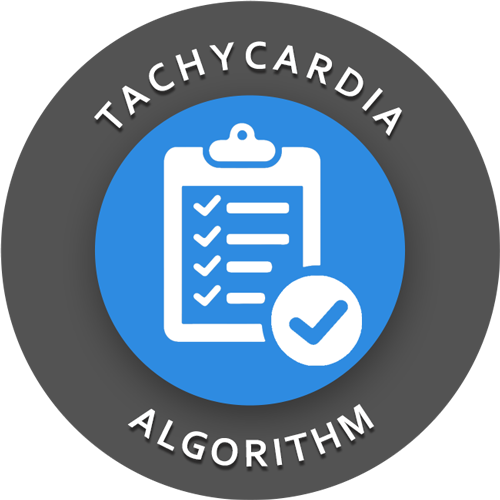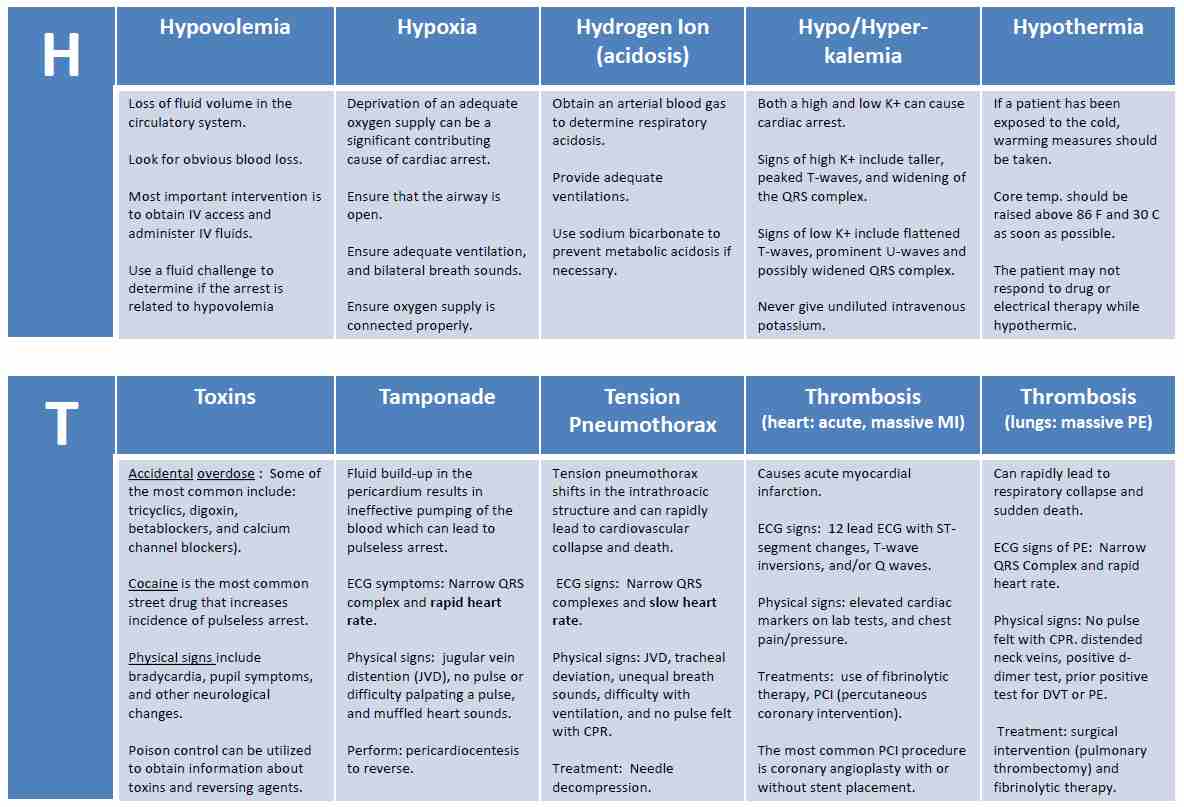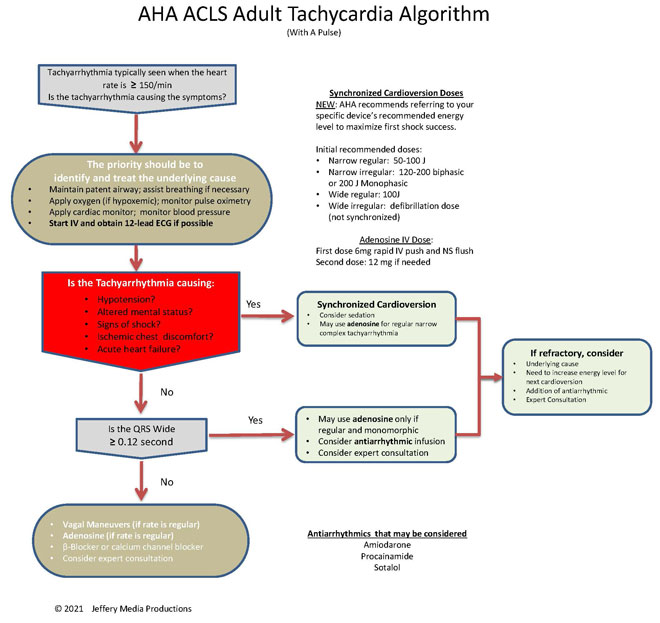 Tachycardia/tachyarrhythmia is defined as a rhythm with a heart rate greater than 100 bpm.
Tachycardia/tachyarrhythmia is defined as a rhythm with a heart rate greater than 100 bpm.
An unstable tachycardia exists when cardiac output is reduced to the point of causing serious signs and symptoms.
Serious signs and symptoms commonly seen with unstable tachycardia are: chest pain, signs of shock, SOA (short of air), altered mental status, weakness, fatigue, and syncope.
One important question you may want to ask is: “Are the symptoms being caused by the tachycardia?” If the symptoms are being caused by the tachycardia treat the tachycardia.
Causes
There are many causes of both stable and unstable tachycardia and appropriate treatment within the ACLS framework requires identification of causative factors. Before initiating invasive interventions, reversible causes should be identified and treated.
The most common causes of tachycardia that should be treated outside of the ACLS tachycardia algorithm are dehydration, hypoxia, fever, and sepsis. There may be other contributing causes and a review of the H’s and T’s of ACLS should take place as needed.
Click below to view the H and T’s table. When done click again to close the diagram.
H’s and T’s Table

Administration of OXYGEN and NORMAL SALINE are of primary importance for the treatment of causative factors of sinus tachycardia and should be considered prior to ACLS intervention.
Once these causative factors have been ruled out or treated, invasive treatment using the ACLS tachycardia algorithm should be implemented.
Associated Rhythms
There are several rhythms that are frequently associated with stable and unstable tachycardia these rhythms include:
- Supraventricular tachycardia (SVT)
- Atrial fibrillation
- Atrial flutter
- Monomorphic VT
- Polymorphic VT
- Wide-complex tachycardia of uncertain type
ACLS Treatment for Tachycardia
Click below to view the tachycardia algorithm diagram. When done click again to close the diagram.
Tachycardia Diagram

or Members Download the Hi-Resolution PDF Here(This will open in another window.)
The first question that should be asked when initiating the ACLS tachycardia algorithm is: “Is the patient stable or unstable?” The answer to this question will determine which path of the tachycardia algorithm is executed.
Unstable Tachycardia
Patients with unstable tachycardia should be treated immediately with synchronized cardioversion. If a pulseless tachycardia is present patients should be treated using the cardiac arrest algorithm.
The AHA no longer provides specific shock dose recommendations for synchronized cardioversion. Instead, they instruct to refer to your specific device’s recommended energy level to maximize first shock success.
For the purposes of a basic understanding of cardioversion, the information about general shock dosages and recommendations will remain in the content on this website.
The initial recommended synchronized cardioversion voltage doses are as follows:
- narrow regular: 50-100 J; i.e., SVT and atrial flutter
- Narrow irregular: 120-200 J biphasic or 200 J monophasic; i.e., atrial fibrillation
- Wide regular: 100 J; i.e., monomorphic VT
- Wide irregular: defibrillation dose (not synchronized)
Stable Tachycardia
Patients with stable tachycardia are treated based upon whether they have a narrow or wide QRS complex. The following flow diagram shows the treatment regimen for stable tachycardia with narrow and wide QRS complex.
- Stable (narrow QRS complex) → vagal maneuvers → adenosine (if regular) → beta-blocker/calcium channel blocker → get an expert
- Stable (wide/regular/monomorphic) → adenosine → consider antiarrhythmic infusion → get an expert
Eric says
hi jeff, i am a cath lab RN, while doing a dobutmaine stress echo, its not uncommon for a patient to have sustained tachycardia HR >130 while testing. after the test is done, if the patients heart rate never comes down what would you recommend the next action to be
Jeff with admin. says
It would depend on how the patient was handling the rate and their current heart function. You would most likely want to give some sort of rate-reducing medication. The main thing that you want to be careful with is to not severely reduce cardiac output (CO) when you give the rate-controlling medications.
Care should be taken in patients with heart failure. The administration of rate control meds can severely reduce CO.
Here is one study that looked at the use of ivabradine for rate reduction.
Ivabradine dobutamine study:
“CONCLUSIONS: A combined infusion of dobutamine and ivabradine had a neutral effect on post-ischaemia LV efficiency and increased left ventricular output without an increase in HR.”
I did send this question off to my brother who is more experienced with critical care issues like this. He may have more to add and I will let you know. He is deployed in the Pacific on the Navy hospital ship “Mercy” right now, and his internet connectivity is limited. It may be a while before I hear back from him. I’ll let you know if he has any feedback.
Kind regards,
Jeff
sharon Campanella says
Wide irregular with a pulse unstable you go to defibrillation dose (not synchronized] . What is first 1st defib dose strength with a pulse ? 360 or start at 120? If AED no choice but with a defibrillator have choice.
Jeff with admin. says
The proper starred goes for defibrillation is 120 J – 200 J. Anywhere within that range will be fine.
Usually your defibrillator will have a set starting dose which is what is recommended by the manufacturer.
Kind regards,
Jeff
YOSRY AFIFY says
NICE
Miriam Reyes Díaz says
Hola Buen Día , en el caso de una TV con pulso que equivale a un complejo ancho regular monomórfico se puede utilizar infusión de amiodarona como antiarritmico ¿la dosis es de 150 mg ? En qué solución se diluye y en cuánto tiempo se va a administrar ?
Saludos
Jeff with admin. says
An amiodarone bolus is appropriate. The dosing is 150 mg bolus over 10 minutes for monomorphic VT with a pulse. Most amiodarone is diluted with D5W to ensure that there is no precipitate that occurs when the solution is mixed with the amiodarone powder. Kind regards, Jeff
Josephine Knowles says
Jeff,
If you have an unstable A-fib or A-flutter and are unsure of how long onset of symptoms. Is it still safe to cardiovert?
Regards
Jo
Jeff with admin. says
There is a risk that the patient may have a thrombus if the onset of A-fib or A-flutter is unknown and the patient is not on an anticoagulant.
In this case, thrombus should be ruled out by performing a transesophageal echocardiogram prior to cardioversion.
Kind regards,
Jeff
Rakesh Raina says
Do you use unsynchronized or synchronized dc cardioversion for pulseless narrow complex tachycardia
Jeff with admin. says
Pulseless narrow complex tachycardia would be treated as PEA and you would use the right branch of the cardiac arrest algorithm. If you see PEA and the rhythm is narrow complex tachycardia there should be a cause that can be identified. Some common causes would be hypovolemia, hemorrhage, and toxins. Look for the cause.
Kind regards,
Jeff
Intan says
If we can give adenosine for unstable monomorphic VT
Jeff with admin. says
Unstable patients with monomorphic VT should be immediately treated with synchronized cardioversion.
Patients with regular, stable monomorphic ventricular tachycardia can be given adenosine.
Kind regards,
Jeff
Kristi Hill says
For unstable Afib and A flutter you first use synchronized cardioversion and then medications second. Is that correct?
Jeff with admin. says
That is correct. Any unstable tachycardia with a pulse will receive immediate synchronized cardioversion.
Kind regards,
Jeff
Jmellanson says
Jeff, hello. I was taking the pre-course assessment for acls that is included in the book. I find it difficult to differentiate between sinus tach and svt rhythm strips. Any pointers? Thanks!
Jennifer
Jeff with admin. says
The main way to differentiate between sinus tachycardia and SVT is to look at the rate. Typically SVT will have a rate that is greater than 170 bpm. Sinus tachycardia will typically not exceed 150 bpm.
Also, with SVT, you will typically not be able to identify any cause for the SVT. Sinus tachycardia is typically caused by something like fever, dehydration, pain, etc.
This being the case if you see a rate over 150 bpm and you cannot determine any obvious cause you are probably dealing with SVT.
Hope that makes sense.
Kind regards,
Jeff
jangrossberg says
So just to be clear on the vagal maneuvers: it wouldn’t hurt to use this technique with sinus tach, but this would be simply a temporary attempt to slow the rate while you are looking for and treating actual causes of tachycardia?
Jeff with admin. says
If you know that you are dealing with sinus tachycardia rather than SVT then you would not want to use vagal maneuvers. Vagal maneuvers delay AV node conduction which allows for full repolarization of the heart and cessation of SVT. SVT responds relatively well to vagal maneuvers and is, therefore, the first line medication for the treatment of SVT.
Vagal maneuvers would not have a significant effect on sinus tachycardia. For sinus tachycardia, you would use other measures to reduce the rate depending on the cause.
Kind regards, Jeff
Peter says
For monomorphic stable vtach is adesonsine or amiodarone first line?
Jeff with admin. says
In the case of REGULAR stable monomorphic ventricular tachycardia adenosine may be attempted before amiodarone is implemented.
Kind regards,
Jeff
elfhose says
For stable atrial flutter and atrial fibrillation we could give either beta blockers or calcium channel blockers right?
Jeff with admin. says
Yes, that is correct. Beta blockers and calcium channel blockers can be used for rate control with afib and aflutter with a rapid ventricular rate.
Kind regards,
Jeff
HHS4717 says
Very helpful information and study tools.
daisyrose says
Jeff,
I have a question about use of vagal maneuver on sinus tachycardia. The material of reference is not from your site but from the 2016 AHA ACLS. In page 139 under Stable Tachycardia it states, ” Treat regular narrow-complex rhythm (except sinus tachycardia) with vagal maneuvers and adenosine. However, in page 140, under Foundational Facts, it states, Sinus tachycardia is caused by external influences on the heart… Sinus tachycardia is a regular rhythm, although the rate may be slowed by vagal maneuvers. So, I’m a bit confused, assuming the patient is stable, could we or should we not use vagal maneuvers for sinus tachycardia? Whats your opinion? Thanks.
Jeff with admin. says
You would not want to use a vagal maneuver’s to treat sinus tachycardia. Sinus tachycardia is caused by some other factor that is not associated with the heart such as fever and pain. You would want to find and treat the cause.
Kind regards,
Jeff
gerrydunphy says
Jeff,
I am wondring about the treatment of stable atrial flutter and atrial fibrillation. After you have monitored VS and started an IV, what drug therapy, if any, is reccommended?
thank you
Gerry
Jeff with admin. says
The treatment of stable atrial fibrillation and atrial flutter is quite varied and is not addressed within the scope of Advanced Cardiac Life support. If this is new onset, they would be started on anticoagulants and worked up for causes. Kind regards, Jeff
Sonya says
Cardiazem
Jeff with admin. says
Yes, Cardizem could be included as one of those treatments.